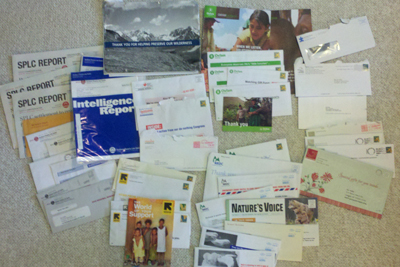 In yesterday’s post, I told you that I suspect that the reason online givers seem to be one-hit-wonders has less to do with online givers being fickle and more with nonprofits not yet figuring out how to do online donor retention well.
In yesterday’s post, I told you that I suspect that the reason online givers seem to be one-hit-wonders has less to do with online givers being fickle and more with nonprofits not yet figuring out how to do online donor retention well.
I promised to share what happened when I gave online gifts to 20 national nonprofits at the end of 2011. Did I get the kind of online communications that would lead to another online gift?
Let me back up just a tad . . . you might remember when I did what ended up being called the “thank you” experiments. At the end of 2008 and 2009, I gave online donations via a giving portal to about a dozen national nonprofits each year (I cashed in miles with Capital One, who partners with Network for Good for charitable giving). My original intent was to analyze the followup communications sent to me after an unsolicited online gift, but the response was so underwhelming that it turned into an experiment on the lack of simple donor acknowledgement and thank you notes.
In 2009 and 2010, only about 1/3 of the organizations acknowledged the online gift with more than an automated email, and just a few started any real kind of conversation with me with newsletters or additional email communications.
Now? Things are little better now, but not much.
I skipped the experiment in 2010, but did it again at the end of 2011. However, I was so underwhelmed (again) by what happened that I was frankly just too depressed by it to report back to you on it. I did blog on January 10, 2012 about an email from the Wilderness Society that I really liked, and they have continued to be one of the best communicators of the 20 orgs I gave to. I also blogged twice in May and July about Charity: Water’s awesome emails reporting back to donors.
But then I read Julie Damon’s blog post last week, knew she was right, and decided to share the results with you after all, so you can get a snapshot of what online donor retention looks like right now.
One of the criticisms of the experiments last time was that I used a giving portal instead of giving directly via the nonprofits’ websites. So this time, I did half and half. I gave 10 $25 gifts directly on the nonprofit’s websites and I gave 10 $25 gifts by cashing in the miles with Capital One/Network for Good like last time.
Let’s see who replied with what . . .
Responses to Gifts Made on Nonprofit Websites
I gave via links from the organization’s website homepage. I’d say about a third are responding well with consistent communications, a third are inconsistent, and a third need to change their approach entirely.
The Wilderness Society has sent me 6-8 emails per month, with a nice mix of asks and updates. I have received one piece of direct mail, which was a thank-you package that specifically mentioned the gift and included a number of other pieces, including some Ansel Adams photos. I feel welcomed and informed.
Charity: Water emails only once or twice a month, but the quality is over-the-top fabulous. No direct mail. While the frequency of communications might be on the light side, the content is absolutely wonderful. Love it.
Guttmacher Institute emails almost weekly, primarily with substantive updates and research results. They have also sent me four pieces of direct mail, including a thank you letter shortly after I made the gift. They are a wonky data-policy org, so the “heavy on substance” communications work. I appreciate it, because as a donor, that’s what I think I am paying for — solid research on a tough policy issue.
Natural Resources Defense Council sent 1-2 emails per month, except May and June, when I got 5 or 6. They’ve also sent 8 pieces of direct mail (all asks, except one newsletter).
The next group is communicating with me, although rather inconsistently.
Autism Speaks sent about 1 email a month through April, but none since then. I received one piece of direct mail in April, which is Autism Awareness Month.
Room to Read sent just 3 emails in 8 months. No direct mail.
Elizabeth Glaser Pediatric AIDS Foundation sent 8 emails in 8 months, but 4 of them came in May. One direct mail ask.
The final third isn’t communicating, or not doing it well.
Southern Poverty Law Center sent me one email in April asking for a renewal. Instead of communicating online, they are trying to get me to give via direct mail or phone — but it’s not going to work with this GenXer because I find their specific tactics incredibly annoying. They’ve sent me seven appeal letters and five newsletters/reports, two of which were wrapped in plastic, which I hate (heard of recycling, people?). But what really annoyed me was that the very first contact after the donation was a telemarketing call in February trying to get me to give monthly, with no thank you or acknowledgement of my recent gift. Of course, it took forever for the telemarketer to pick up the call (I’m all Hello? Helloooo? Hellooooooo? then the click and his voice comes on). Then he butchers my name (naturally) and is all chatty without introducing himself. I had to ask who I was talking to. BLECH!
I have received no online communication at all from the American Heart Association (they sent one piece of direct mail, but I think I get it every year) or the National Military Family Association.
As you can see, there are huge differences in how nonprofits are doing online donor stewardship, from weekly communications to no communications, sometimes adding direct mail, sometimes not. Remember, these were all gifts made on their own websites.

Direct Mail Received in Response to Online Gifts
Responses to Gifts Made via a Giving Site
Now let’s look at the ten nonprofits who I donated to via the Capital One Giving Site. These gifts arrive at the nonprofit a bit differently, first going through Network for Good, who then distributes them to the charity. That process means the charity often won’t receive the gift for a month or so.
Oxfam America’s first email came on February 17, with the subject line, “Kivi, What’s Important to You?” I have received a total of 22 emails from Oxfam this year. They also sent a thank-you postcard, along with two newsletters and four other pieces of direct mail. Nice work.
The National Coalition for the Homeless has sent about 10 emails in 8 months, starting on February 24. They also sent a paper thank you letter dated January 10. Quick, and with a personal note too!
That’s it for the online communications from this group.
I have received five pieces of direct mail from International Rescue Committee, one labeled Thank You and one labeled Welcome. So they appear to want to move me to direct mail giving as well, but in a less annoying way than SPLC.
Feeding America sent a paper thank you letter; nothing after that.
Brady Center to Prevent Gun Violence sent one direct mail appeal.
I received no communications whatsoever (after the automated receipt from Network for Good on their behalf) from the other five: Rails to Trails Conservancy, Environmental Working Group, First Book, Homes for Our Troops, or Women for Women International. I am left to assume that the problem is that my gift (and I assume others via the various giving sites) get lost in their systems for whatever reason. That’s too bad, for them and for donors like me who would like to hear from the charities they support.
So What Does This Mean?
Before I did this analysis of just how much communication I had received from each organization, I asked myself to pick the groups from the total list of 20, who off the top of my head, were sticking out to me as communicating with me regularly as a donor.
I picked Guttmacher, Wilderness Society, and Charity: Water, and no surprise, their communications stood out after the analysis too, for frequency, consistency, and in Charity: Water’s case, outstanding messaging. Southern Poverty Law Center also stood out for me, but not in a good way, because of the annoying plastic mail and phone call.
Based on this review, the Natural Resources Defense Council, Oxfam, and the National Coalition for the Homeless appear to be communicating frequently, but they didn’t really stand out that way in my memory. I’ll have to go back and look more closely at what they are sending me to figure out why those communications aren’t quite clicking into my memory like the others.
But here’s the point: How can we possibly expect online donors to give again if we aren’t communicating with them appropriately online? I am all for multi-channel marketing, so I applaud those organizations that supplemented — not replaced — their online communications with direct mail. But even more importantly, the content of those communications has to be really good. You have to thank, and report back, offer other ways to engage, and ask. Not just silence, and not just more asking.
For the record, I’m 43, which I realize is not in the golden time of giving prime (or whatever it’s called when you give a lot of money over age 65). But I do give thousands to charity each year, and I don’t write paper checks, except to little local organizations. If you want my money, you’ll have to impress me online. I don’t see that changing, no matter how much direct mail you send me.

![12 Things You Can Stop Doing Right Now [Infographic]](https://www.nonprofitmarketingguide.com/wp-content/uploads/2025/01/Stop-Doing-2025-Info-hung-up-500x383.png)



